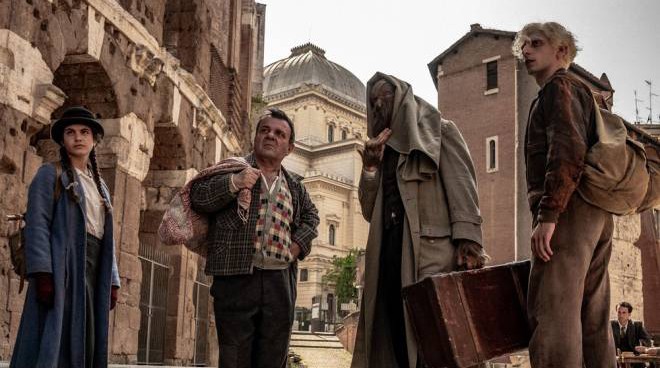Fairytale
Sokurov's latest cinematic endeavour is surreal and complex, as well as a natural follow-up to his previous filmography - and a deep yet entertaining film.
Fairytale can be considered as an epilogue or a fifth chapter to Aleksandr Sokurov's quadrilogy of Power, a loose cycle of films that center on characters bound to power in settings in which they would lack power. Moloch featured Hitler on a retreat, Taurus portrayed Lenin during his last years, The Sun featured Emperor Hirohito's final days of rule, and the conclusive film, Faust, reimagined the romantic-age story emphasizing the lack of control pf the character. Fairytale fits perfectly in Sokurov's quadrilogy as a coda or as an epilogue as it portrays four of the most pivotal european leaders of WWII - Churchill, Hitler, Mussolini and Stalin - in a sort of limbo or inferno of dantesque inspiration, awaiting their entrance to the afterlife.
Set amidst cyclopical structures inspired by the paintings of Piranesi, the interactions of the four ccharcters have both a satyrical and a surreal tone, with each leader mocking one another, or praising the other's uniform, and so forth. Yet, the film hardly qualifies as a satyre only. It is a meditation on power from a new perspective that emphasizes the ingenuity of these leaders, responsible for some of the most crude genocides embedded in recent european history, as they are unable to leave their ideologies behind.
Some of the main topics that are dissected in the film are the relationship of power between leaders and their masses - portrayed as literal oceans of people - and the concept of empire, the admiration that all leaders share towards Napoleon. The choice of including Churchill is most intriguing, as he is generally justified by public opinion due to his military heroics, yet in Fairytale is put on the same level as the three other totalitarian leaders, with his imperialist ideology exposed, his respect for a classist system outlined. He in no ways seems an oddball, except for his disdain towards the crowds.
Religion and religious figures also play an interesting role, with a Christ that is almost statuary, forced to suffer on for the sins of people - in particular those of the protagonists - and that speaks aramaic, since each character speaks their own language.
Sokurov has often claimed that his great dream is to adapt Dante's Divine Comedy, the influence of which can be perceived continuously, even through the repetition of the first verses by the various characters. There was no dohbt before, but if this film is any indication, Sokurov may be the perfect filmmaker for the near impossible task of transferring Dante's work to the screen.
The overall tone of the film however reminds more of Beckett's surrealism: the unexplicable dialogues, the sense of anticipation for the entrance to the afterlife which never occurs both enthrall and confuse, without diminishing the interest.
The most revolutional aspect of the film is the fact that it blends animation and live-action through the use of actual archive footage of the four historical figures who are imposed over paintings and backdrops, dubbed and edited in order to interact. The technology can be best described as a very evolved version of deepfake and Terry Gilliam's animations for the Monty Python show, but at a degree of accuracy that makes the "performances" almost flawless and the nature of the animations in no way distracting. The parallel with Monty Python is only in the form, as Sokurov's film is much more complex and deep in its form of satyre. With Fairytale, Sokurov achieves a form of art through technology that very few productions have achieved, and demonstrates that even after such a long and intense career such as his, he has still much to tell.



Comments
Post a Comment